How to get rid of mealybugs on orchids is a question I often get.
While mealybugs are easy to eliminate in small numbers, they get cumbersome once the infestation grows. This happens fast.
Mealybugs are fascinating to read about or watch how they interact with plants in gardening documentaries.
On your plants, the results are not fascinating at all. Mealybugs are fast orchid destroyers.
The males are said to be shorter-lived, but that does not matter. What does matter is they are ALL killed.
Did you know the long-tailed mealybug does not lay eggs in the soil?
The female of the Pseudococcus longispinus species gives birth to live young. The live young from the female bugs can be as many as 600 in under ten days.
That is their lifespan. It does not take a math genius to determine that those numbers on any orchid plant are fatal.
Read on to discover the necessary steps required to eliminate mealybugs before they destroy an orchid.
Table of Contents
How to Get Rid of Mealybugs on Orchids
To get rid of Mealybugs on orchids, apply rubbing alcohol (isopropyl alcohol) using a cotton swab directly onto the mealybugs. In addition, use neem oil or insecticidal soap directly on the leaves, stems, and soil of the orchid. Repot the plants, prune the roots, and sterilize the potting soil.

1. Treating the Leaves
The orchid leaves are the area to tackle to eliminate the live mealybugs.
There is little point in treating any eggs or orchid bugs in soil when there are actively feeding and breeding on the foliage.
Three solutions exist to treat the leaves on orchids.
- Rubbing alcohol
- Insecticidal soap
- Neem oil
Either of these is how to get rid of mealybugs on any plant. Orchids are no different.
What is different is the time of day you apply these solutions. The soapy solutions coat the leaves.
Applying them during high temperatures (above 85 degrees Fahrenheit) can cause leaf burn on orchids.
Apply these by rubbing or spraying the solutions over the leaves in the morning, or move the plant into the shade to prevent hot sunlight from heating the oil.
Every area of the leaves and stems needs to be coated.
Applying Rubbing Alcohol to Get Rid of Mealybugs on Orchids
Use rubbing alcohol in the morning when the plant pests are most active.
Drench a cotton swab in rubbing alcohol. Apply the solution directly onto the visible mealybugs.
The mealybugs will burn and dissolve from the isopropyl alcohol.
Apply Insecticidal soap and neem oil over several weeks to get rid of mealybugs
Mealybugs are soft-bodied insects, according to the University of Florida. They are sneaky critters that will hide between the folds of leaves and tight crevices that make them hard to detect.
Even one survivor will retrigger the reproduction process.
The process must be repeated multiple times because these work as contact insecticides only.
When spraying, the soap or oil must come into direct contact with the soft-bodied skin of these insects.
Upon contact, mealybugs dehydrate within hours.
If they are missed when spraying, the leaves will dry, and the insecticide will no longer be effective.
Repeat applications daily. Each morning, knock the leaves to knock off as many mealybugs (live and dead) as possible, then respray the leaves.
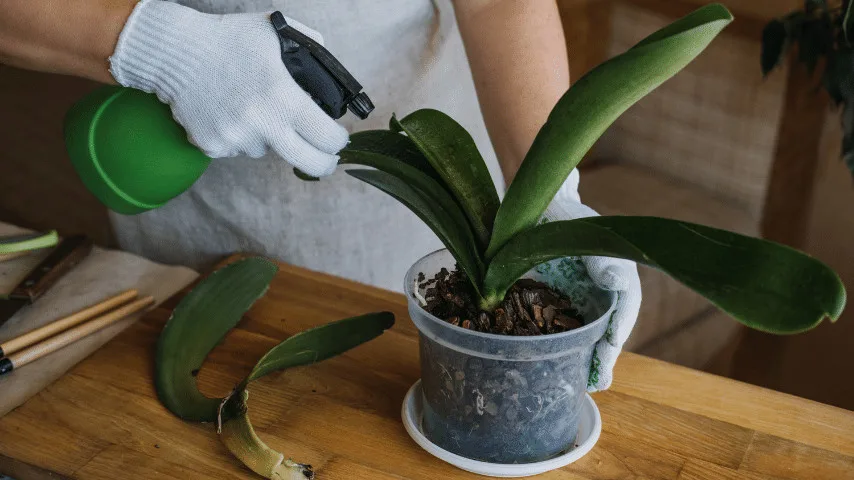
2. Treat and Replace the Soil Mix
Getting rid of the mealybugs on orchids is not a guarantee that the plant is entirely free from them.
The mealybugs feed on the plant leaves, preferring to stay above the soil.
However, they do drop eggs onto the soil. If those are not removed or treated with a pesticide,
root mealybugs are the next problem that needs to be addressed.
Root mealybugs are tiny white bugs in soil that deplete the roots and plants of nutrients.
Adult mealybugs do not bore into the soil. They lay their eggs or live young on the soil surface.
Once those are hatched, the bugs bore into the soil and feed on the roots and soil nutrients.
As the bugs mature into adult mealybugs, they venture beyond the soil surface, get onto the leaves, and the whole process starts again.
To truly eradicate mealybugs from orchids, the potting media should be replaced or at the very least, sterilized.
The potting mix can be sterilized like you would sterilize the soil for houseplants.
Using steam, bake the mix in the oven, in the microwave, over a grill, or solarization by leaving the mix in direct sunlight to cook.
The aim is to increase the soil temperature to at least 180 degrees Fahrenheit and keep it around that temperature for at least a half-hour.
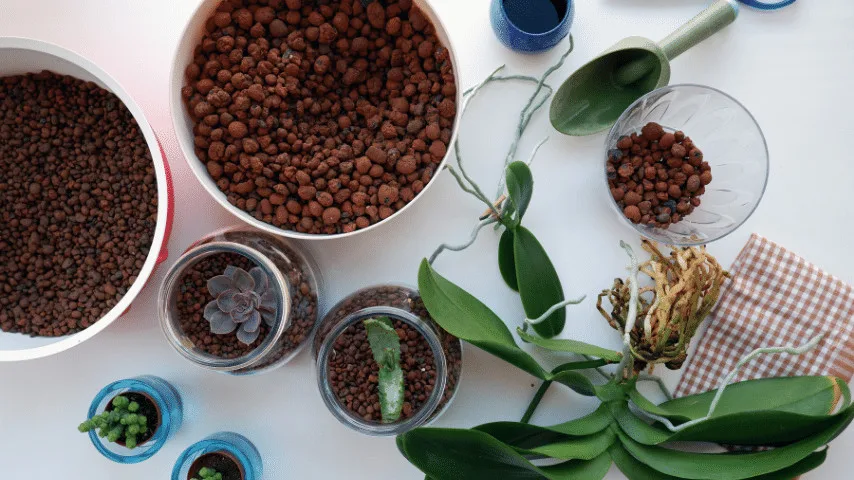
3. Washing Orchid Roots
Treating the orchid roots is different. Exposing the plant’s roots to extreme temperatures can do as much damage as the root mealybugs.
To wash the roots at high temperatures, boil some water, then let it cool. Dip the roots in purified water while still warm and let them soak for around ten minutes.
The warm temperatures and short time will be sufficient to either drown any hitchhiking mealybugs attached to the roots or knock any lingering eggs loose into the water.
After soaking the roots, gently shake them and leave them to air dry for a little while.
As it is drying, prepare the new container by wiping it down with rubbing alcohol (70% isopropyl).
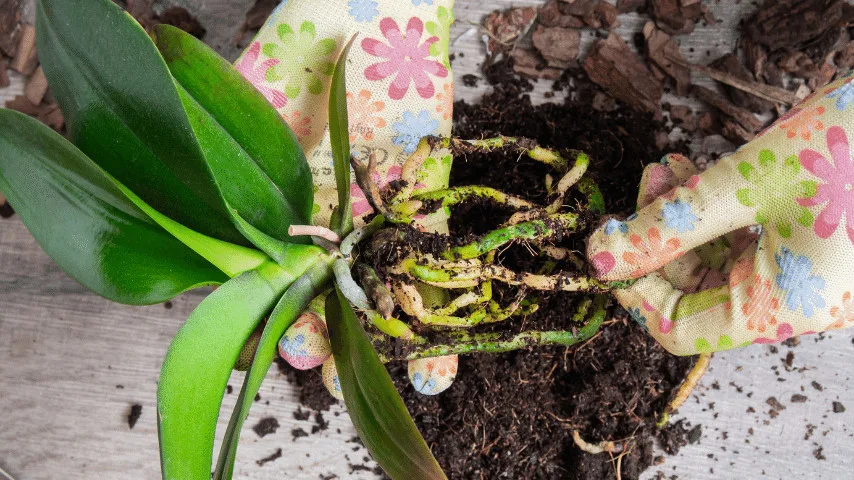
4. Pruning Damaged Roots
Before repotting the orchid in the freshly sterilized potting mix, inspect the roots for damage and prune off any rotted roots.
It is straightforward if you’re unsure how to cut orchid roots. After disinfecting your pruners or scissors, inspect the roots for soft brown patches.
Those are rotted. To cut them off, make the cuts diagonally.
Once finished pruning the roots, spray them with hydrogen peroxide (3%) solution.
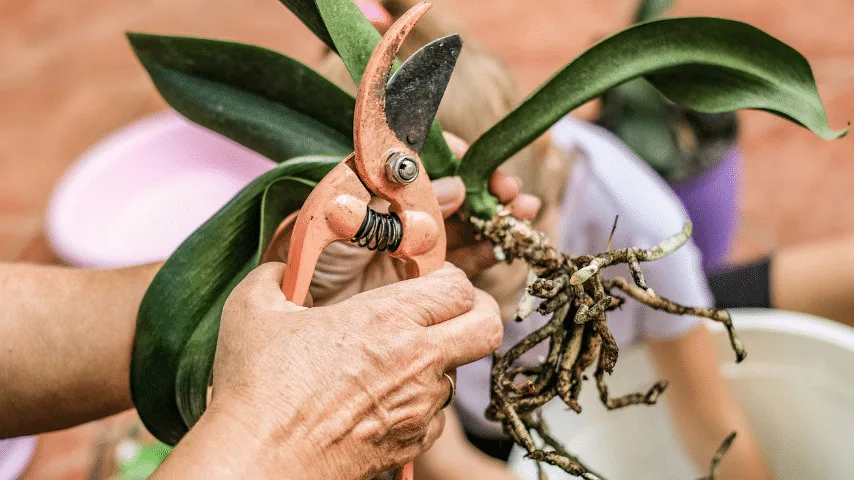
Repotting your orchid
Repot your orchid in diatomaceous earth (DE) through the potting mix.
The sharpness will take care of any lingering eggs that did manage to survive your attempts at sterilization.
Mealybugs are stubborn and difficult to get rid of, so every trick in the handbook must be implemented to ensure they do not return.
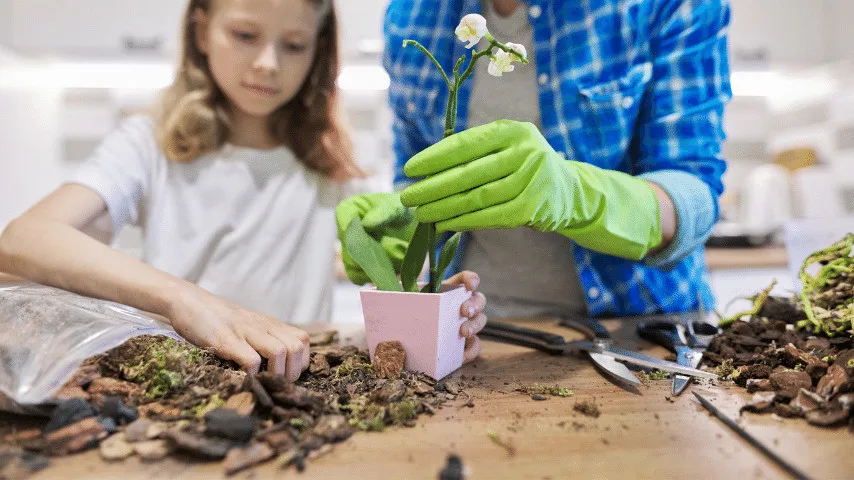
Home remedy for mealybugs on orchids
A home remedy that works great for removing mealybugs on orchids is:
- A few drops of dishwashing soap
- Dilute with 1 quart of water (0.9 L)
- Use a spraying bottle to apply it onto the plant and soil
Orchid mealybug spray
If you don’t want to rely on a home remedy, you can buy a mealybug spray as an insecticide. Systemic insecticides are the most effective ones. They are absorbed by the plants and offer prolonged protection.
You have to be careful when applying them, as they cannot be allowed to get into the groundwater. They can be harmful to the environment.
When spraying the orchids, protect your mouth with a facemask and use gloves.
Frequently Asked Questions
How did my orchid get mealybugs?
Mealybugs are everywhere. The only way to prevent mealybugs is regularly coating the leaves with a neem oil application. It is a fungicide and an insecticide. If the leaves are not protected, mealybugs, thrips, aphids, and other sap-sucking pests will find the plant and set up home.
Do ants eat mealybugs?
Ants and mealybugs have a symbiotic relationship. Ants do not eat plants or mealybugs. They feed on honeydew – the excrement of sap-sucking insects. Ants protect sap-sucking insects from natural predators. Removing mealybugs will cause the ants to move to another food source.
Conclusion
To get rid of mealybugs on orchids use rubbing alcohol, neem oil or horticultural soap.

Daniel has been a plant enthusiast for over 20 years. He owns hundreds of houseplants and prepares for the chili growing seasons yearly with great anticipation. His favorite plants are plant species in the Araceae family, such as Monstera, Philodendron, and Anthurium. He also loves gardening and is growing hot peppers, tomatoes, and many more vegetables.


